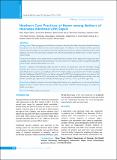Please use this identifier to cite or link to this item:
https://hdl.handle.net/20.500.14356/1382| Title: | Loneliness and Depression among Older People Living in a Community of Nepal |
| Authors: | Chhetri, Bima Thapa Bhandari, Sunita Shah Karna, Basant Kumar Chaudhary, Ramanand Yadav, Upendra |
| Citation: | ChhetriB. T., BhandariS. S., KarnaB. K., ChaudharyR., & YadavU. (2019). Newborn Care Practices at Home among Mothers of Neonates Admitted with Sepsis. Journal of Nepal Health Research Council, 17(2), 178-184. https://doi.org/10.33314/jnhrc.v0i0.1628 |
| Issue Date: | 2019 |
| Publisher: | Nepal Health Research Council |
| Keywords: | LONS Newborn care Practice |
| Series/Report no.: | Apr-June, 2019;1628 |
| Abstract: | Abstract Background: Child rearing practices and family environment determine the health of newborn. Harmful newborn care practices are the risk factors for late onset neonatal sepsis. The objective was to identify newborn practices related to breast feeding, cord care, hygiene of newborn and thermal care practice at home of admitted neonates with diagnosis Late Onset Neonatal Sepsis in pediatric unit of B.P. Koirala Institute of Health Sciences tertiary center in eastern Nepal. Methods: Descriptive cross sectional study was carried out from December 2014 to January 2015 using consecutive sampling. Semi structured, pretested questionnaire was used to interview 40 mothers. Data were analyzed using SPSS 20, descriptive and inferential statistics were used. Results: Initiation of breastfeeding within one hour of delivery was practiced by only 40% of mother. Among neonates, 65% were given colostrum, 25% were given pre lacteal feed, and 45% were given formula milk and animal milk. Mustard oil was used to care umbilical cord by 72.5 %. Hand washing was practiced by 62.5 % before touching the baby. Application of kajal (52.5%) in eyes and use of mustard oil (95%) for massaging newborn was common. For thermal care, burning charcoal (75%) was mostly used. The study revealed association between newborn care and mother education, per capita income of family and family type (p =0.012, p= 0.012, p=0.039) respectively. Conclusions: Majority of practices in breast feeding and thermal care were good however in cord care and newborn hygiene practices was poor which stresses the need for the promotion of health education program to mothers by health care facilities. Keywords: LONS; newborn care; practice |
| Description: | Original Article |
| URI: | http://103.69.126.140:8080/handle/20.500.14356/1382 |
| ISSN: | Print ISSN: 1727-5482; Online ISSN: 1999-6217 |
| Appears in Collections: | Vol. 17 No. 2 Issue 43 Apr - Jun 2019 |
Files in This Item:
| File | Description | Size | Format | |
|---|---|---|---|---|
| 1628-Manuscript-10742-1-10-20190804.pdf | Fulltext Download | 262.29 kB | Adobe PDF |  View/Open |
Items in DSpace are protected by copyright, with all rights reserved, unless otherwise indicated.
